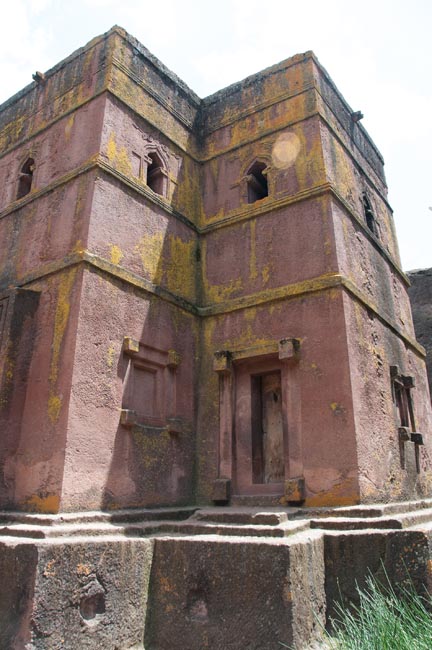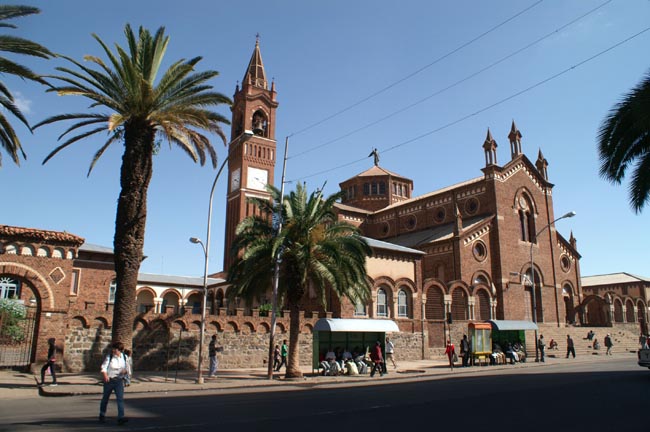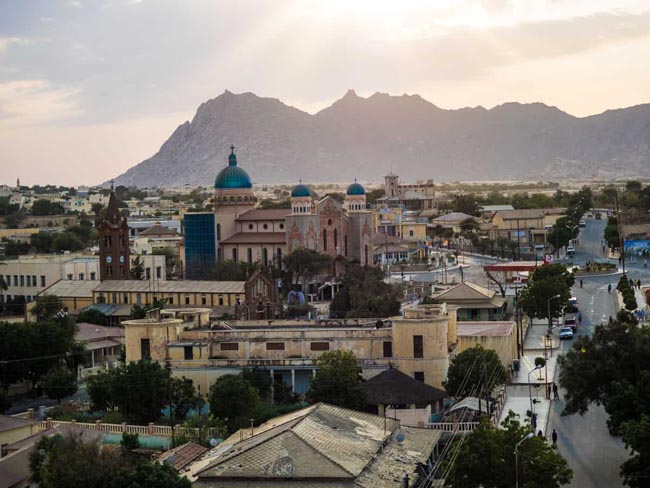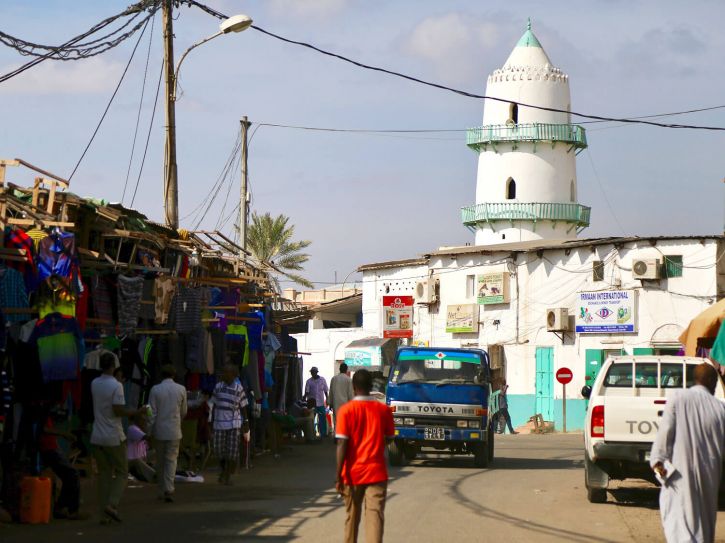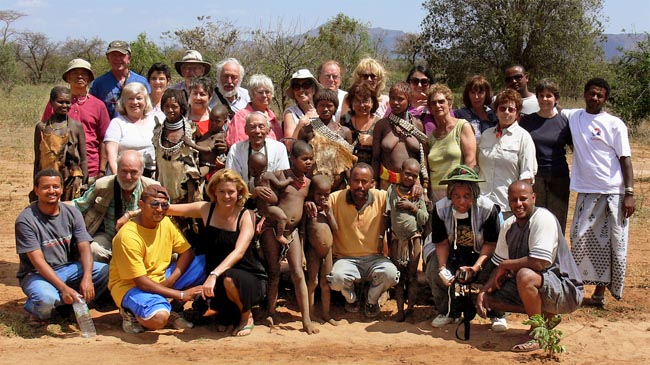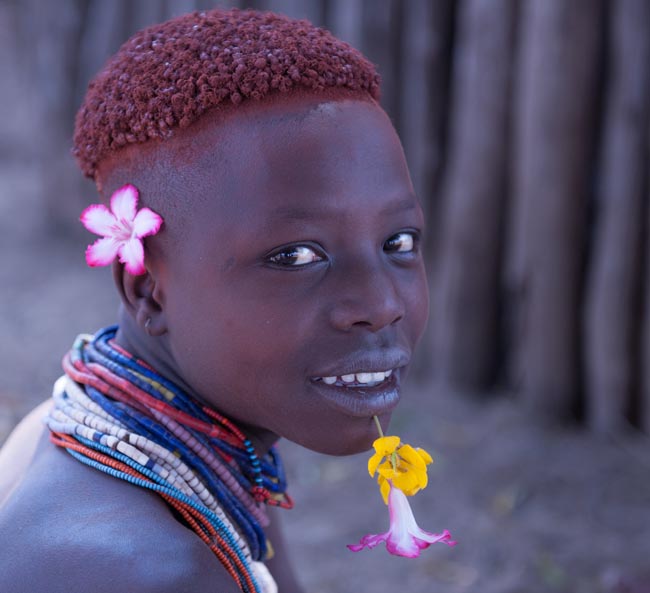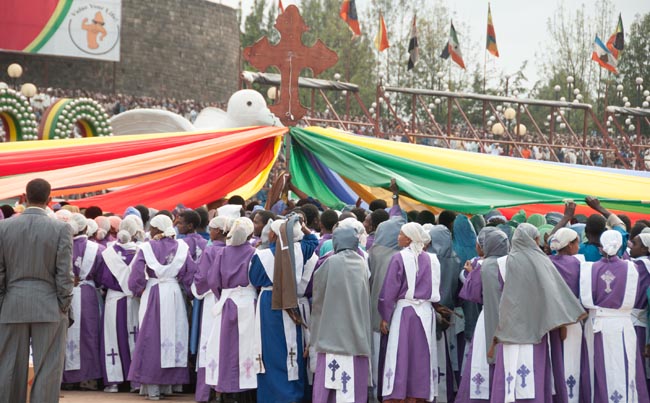Download Itinerary
Day 1 Arrival in Addis Ababa, Ethiopia
Welcome to Addis Ababa, the largest city on the 'Horn of Africa.'
The Horn of Africa is the easternmost extension of African land and is usually defined as the region that is home to the countries of Djibouti, Eritrea, Ethiopia, and Somalia, whose cultures have been linked throughout their long history. Overall, the Horn of Africa is estimated to consist of over 2 million sq kilometers (772,200 square miles), most of which boasts a semi–arid to arid climate. Despite difficult living conditions in many parts of the region, recent estimates put the population of the region at about 90.2 million.
The HOA became a major center for trade and commerce around 500 C.E; a major commodity traded along these routes was ivory. Indeed, the Greeks were so involved with the elephant hunting trade in the Horn of Africa that the Greek language was occasionally used on official state documents. Other important exports of the region included frankincense and myrrh, both luxury goods that were highly valued in classical antiquity. Despite the recent political strides in Ethiopia and Eritrea, the Horn of Africa as a whole has faced devastation in the recent years, and many of the religious conflicts in the region continue to remain unsolved, particularly the tensions between Christians and Muslims.
Overnight in Addis Ababa.
Included Meal(s): Dinner
Day 2 Addis Ababa: City Tour
This morning we tour Addis Ababa, Ethiopia's capital, which translates as "New Flower" in the Amharic language. The city shows little sign of losing its youthful, lusty edge and is the pulsing heart of this eclectic nation's resurgence as one of the world's fastest-growing economies. "Addis," as it's often simply known, is the world's third-highest capital city at 2400 meters (7,880 ft), and has worn its heart on its sleeve since it was founded by Ethiopian Emperor Menelik about 1892.
Although not well-known outside the country, the Ethiopian National Museum is a world-class museum; truly a hidden gem! The most famous exhibit is the replica of Lucy, an early hominid, but the museum offers much more. With Ethiopian civilization being one of the oldest in the world, the artifacts within the museum span thousands of years, including some from its earliest days. During our visit, we'll see a wide variety of artifacts, from sculptures to clothing to artwork, both traditional and modern.
Next is the Ethnological Museum, a fascinating place with exhibits relating to the history and culture of Ethiopia. There are many displays of the various ethnic groups with information about each of their lifestyles. A large amount of ethnic outfits, instruments, tools, and other artifacts accompany each ethnic exhibit, making it one of the most interesting museums in the city.
We also visit the Holy Trinity Cathedral, the second most-important place of worship in Ethiopia and the final resting place of Emperor Haile Selassie.
At some point today we should be able to sample Ethiopia's 'Black Gold'. It's impossible to separate Ethiopian culture -- that unparalleled Ethiopian-ness -- from coffee, and this is the land of the finest Arabica coffee. As legend would have it, it was discovered by an Ethiopian shepherd boy and his goats sometime around the sixth century.
Overnight in Addis Ababa.
Included Meal(s): Breakfast and Dinner
Day 3 Addis Ababa, Ethiopia - Fly to Hargeisa, Somaliland
Today we fly to Hargeisa - welcome to Somaliland!
Somaliland, officially the Republic of Somaliland, is a self-declared state, internationally considered to be an autonomous region of Somalia. The local Somaliland authorities declared the region's independence from the rest of Somalia in May 1991, but neither the Somali federal government nor any other country or international organization has recognized its sovereignty. The area is viewed as much safer than most of its neighbouring East African countries. The local government is very anxious to show its stability and, as a result, foreigners are generally treated with respect and interest. This is a truly unique travel experience, well off the beaten path, and in a "country" that doesn't exist!
We arrive in Hargeisa and transfer to our hotel; we spend the afternoon exploring the city and seeing some of its sights, including the War Memorial, with its unusual monument of a crashed MiG fighter plane, and the gold and camel markets. There is very little tourism (and no tourist industry) here, as almost all visitors are working for an NGO or other organizations.
Overnight in Hargeisa.
Included Meal(s): Breakfast and Dinner
Day 4 Hargeisa - Laas Geel Complex - Berbera
Today we depart for Berbera, on a well-secured and trafficked road, with a stop at Laas Geel en route.*
Laas Geel, also spelled Laas Gaal, are cave formations which contain some of the earliest known cave paintings in the Horn of Africa. Laas Geel's rock art is estimated to date to somewhere between 9,000 and 3,000 years BC. The site is placed on a granite outcrop that rises from a plateau at an altitude of 950 meters above sea level, at the confluence of two seasonal rivers, a key fact to explain the existence of rock art in the outcrop. Even today, the name of the site (“the camel’s well” in Somali) makes reference to the availability of water near the surface of the wadis.
The paintings at Laas Geel are spread across 20 shelters split into three levels some of which can be as wide as 10 meters and as deep as 5 meters. All the shelters and paintings are within walking distance from each other. The paintings in Laas Geel depict scenes of daily life of the nomads who inhabited the area and their animals as well as ceremonial scenes. Some of the paintings are monochrome and others polichrome but they are all remarkably well-preserved and vivid for something which is thousands of years old. The colours used are warm, either red, yellow or orange.
After visiting the site we continue to Berbera, with its interesting architecture from both the Ottoman and British periods. Berbera is a coastal city which serves as the biggest seaport for Somaliland, with clean and unspoiled beaches on the Gulf of Aden. This evening you might try some of the seafood for which the town is famous.
* To travel outside of major cities, foreigners are not required by law to take an armed guard with them as these routes are well-patrolled and secure; however, out of an abundance of caution, we choose to use this service for our journeys to/from Berbera, including our time at Laas Geel.
Overnight in Berbera.
Included Meal(s): Breakfast and Dinner
Day 5 Berbera - Hargeisa
We spend the morning exploring Berbera, especially the old quarter of the town.
In antiquity, Berbera was part of a chain of commercial port cities along the Somali seaboard. During the early modern period, Berbera was the most important place of trade in the entire Horn of Africa. It later served as the capital of the British Somaliland protectorate from 1884 to 1941, when it was replaced by Hargeisa. It’s hard to believe when you see it, but Berbera was once a busy town. Lying on the Gulf of Aden opposite Yemen, it has been a centre of maritime trade since ancient times. Today this shady town consists mostly of crumbling buildings and mud-and-thatch houses. Berbera’s potential is immense, though, with superb beaches and a relaxed atmosphere. If, one day, Somaliland appears on tourist brochures, Berbera will probably top the bill.
After a break for lunch we'll return by road to Hargeisa.
Overnight in Hargeisa.
Included Meal(s): Breakfast and Dinner
Day 6 Hargeisa, Somaliland - Fly to Djibouti City, Djibouti
Today we fly to Djibouti City (likely via Addis).
Djibouti City is the capital and largest city of Djibouti, located in the coastal region on the Gulf of Tadjoura. Home to around 600,000 inhabitants, the city contains over 60% of the nation's population. The settlement was founded in 1888 by the French on land leased from the ruling Somali and Afar Sultans. During the ensuing period, it served as the capital of French Somaliland and its successor the French Territory of the Afars and Issas. Under its veneer of urban bustle, the city remains a down-to-earth place.
Depending on our arrival time, we may begin our Djibouti City sightseeing upon arrival.
Overnight in Djibouti City.
Included Meal(s): Breakfast and Dinner
Day 7 Djibouti City: City Tour - Tadjoura & Sables Blancs
Djibouti City is the capital and largest city of Djibouti, located in the coastal region on the Gulf of Tadjoura. Home to around 600,000 inhabitants, the city contains over 60% of the nation's population. The settlement was founded in 1888 by the French on land leased from the ruling Somali and Afar Sultans. During the ensuing period, it served as the capital of French Somaliland and its successor the French Territory of the Afars and Issas. Under its veneer of urban bustle, the city remains a down-to-earth place, with jarring cultural and social combinations.
This morning we will enjoy a panoramic tour of the city during which we plan to see the colourful market, the railway station, the main port and the central mosque.
Later we will take a private boat across the Gulf of Tadjoura to Tadjourah, the capital of one of the six regions in Djibouti (+/- 1.5 hours). Upon arrival we will head straight to our hotel which is situated right on the beach at Sable Blancs.
You will have some free time to relax in the afternoon before dinner at our hotel.
Overnight at Tadjoura.
Included Meal(s): Breakfast and Dinner
Day 8 Tadjourah - Lake Assal - Djibouti City
Today we travel by road southwest to Lake Assal, located in the north-central part of Djibouti. Shortly after our departure from the beach area we will make a brief stop in Tadjoura, known as the 'White City.' The Sultanate of Tadjoura has many white buildings and is a historic city. This was where the French colonization started when the sultan granted a piece of land to the French. Soon Djibouti City became the most important city of the country. Nowadays Tadjoura serves as an important port and fishing settlement.
Lake Assal is a saline lake, which lies 155 m (509 ft) below sea level in the Afar Triangle, making it the lowest point on land in Africa and the second-lowest land depression on Earth after the Dead Sea. Situated in the Danakil Desert, the lake is bounded by hills on the western region. No outflow occurs from the lake, and due to high evaporation, the salinity level of its waters is 10 times that of the sea, making it the most saline in the world after Don Juan Pond, Antarctica. Salt extraction by the Afar nomad tribes of camel drivers and Issas from Lake Assal's salt bank established the ancient caravan routes. These linked the lake with the mountains of Ethiopia for barter trading such items as sorghum, coal, and other commodities. Salt was also bartered with South Abyssinia for items like coffee, ivory, musk, and also (historically) slaves. It was a source of wealth for the local tribes.
After a day of scenic stops and short walks we will continue our journey back to Djibouti City.
Overnight in Djibouti City.
Included Meal(s): Breakfast, Lunch and Dinner
Day 9 Djibouti City, Djibouti - Fly to Asmara, Eritrea
Today we fly from Djibouti City to Asmara (via Addis Ababa). Welcome to Eritrea!
Filtered by Italian artistic sensibility, Asmara has welcomed practically all the styles of the early twentieth century, becoming the Modernist city of Africa par excellence. A sort of white paper where the Italian architects of Italy's fascist era, far from the constraints of the mother country, could design the city of Utopia. This is definitely a place to test yourself with the most different architectural styles in vogue in the first decades of the last century in Europe.
Overnight in Asmara.
Included Meal(s): Breakfast and Dinner
Day 10 Asmara: City Tour
This morning we'll begin our discovery of Asmara, a UNESCO World Heritage Site.
Asmara has the world's highest concentration of architectural styles of the 1930s. Simple geometric shapes of classical proportions are enhanced by slender horizontal curves and soaring stepped towers. We find portholes, loopholes, and elongated windows, circular balconies and jutting wings; cylindrical stairwells and arched canopies, curved shelves and bizarre zig zag chimneys. Originally whitewashed, this beautiful city has been enriched by the colours of Africa with apricot and turquoise, burgundy, lime green and pale gold pastels. Marble vases suspended with geraniums and dahlias, and occasionally we discover a Renaissance villa, with wrought iron gates and turret towers, a French castle tower, or a Palladian villa with Corinthian columns and pink tympanum. Art deco villas, cubist, rationalist, expressionist, futurist and neoclassical architectures decorate the corners of the city with a Western style magnificence that may leave you perplexed.
One of the greatest monuments of the city is the Catholic Cathedral of Santa Maria, in pure Lombard Romanesque style with interior completely frescoed. We'll visit the National Museum, with archaeological finds of ancient civilizations and a rich collection of arts and typical clothing of the nine ethnic groups of the country.
The Coptic church Nda Mariam (E. Gallo, 1920) built over the ancient one, is also worth a visit. The best synthesis about liveliness and colour of ethnic Eritrean groups is the Medeber, a market dated eighteenth century, where artisans in small shops mould objects of all kinds by recycling metal.
The Cemetery of Asmara, located on a hill from the red earth, is a place filled with light, colour, sound and it is one of the most important places to get a historic insight into the Italian adventure in Eritrea.
Overnight at Asmara,
Included Meal(s): Breakfast and Dinner
Day 11 Asmara: Excursion to Kohaito
After breakfast we have an excursion south to Kohaito.*
At Dekemhare we have a short walk into the center, with the Italian style houses of the early 1900's.
Proceeding to Segheneyti, where we will observe some majestic sycamore trees, the largest in the country. The most beautiful is reproduced on a banknote of the country. Arrival in Senafe and Kohaito, where the ruins of the ancient Axumite cities of Metara and Coloe rise.
Based on the different names in the area that are related to the elephants, Kohaito is believed to have been a center of ivory trade and an agricultural area due to the many remains of stones for grinding. At the beginning there were only 46 sites identified, but now the number has risen to 900.
Particularly interesting is the dam called Safira in Kohaito, 2500 years old, whose construction is attributed to the 6th century before Christ. The style and solidity of the dam shows how the population possessed an advanced construction technology. According to legend, the Queen of Sheba quenched herself with the waters of this dam. Although detailed scientific research has yet to be completed, Kohaito's civilization lasted about 1,000 years and is antecedent to the Axumite civilization. The strategically important position of Kohaito meant that this area served as a "bridge" between Adulis and other civilizations, such as Metara, Keskese and Belew-Kelew.
Another historically important place is Keskese, located in an area of 11 square kilometers distant 125 kilometers from Asmara, near Senafè. Among the many remains in the place, of great interest are some fallen steles (10 meters in length), five stone pillars bearing Sabee writings, remains of large and small walls, and cemeteries. Also scattered throughout the area are various crafts, stone tools, stone and brass ornaments. Although no detailed scientific research has been conducted so far, based on the study of the materials found on the surface and on the findings written in the Sabean language, it is believed that Keskese developed towards the ninth century before Christ.
Return to Asmara.
Overnight in Asmara.
* Please note that this excursion is subject to confirmation of necessary road permits. In the unlikely event that permits are not obtained, our excursion will turn around from the Valley of the Sycamores.
Included Meal(s): Breakfast and Dinner
Day 12 Asmara: Train Excursion - Massawa
After breakfast we enjoy an excursion on board the legendary train pulled by locomotives from Asmara to Nefasit and back.*
You will have the rare opportunity to travel along one of the most daringly-designed railways in the world, whose construction began in 1897, on board trains that go back to the times of the colonies. We will cover the stretch Asmara-Arbaroba, about 18km one of the most striking and scenic part of the entire route.
A century ago, Italians built a futuristic railway in Eritrea. Today, amid the wounds of a recent war, steam locomotives have returned to run on the tracks of the former Italian colony. An extraordinary enterprise commissioned by the Asmara Government and carried out by over seventy-year-old railway workers, the railway line that connects the cities of Asmara and Massawa, exceeding almost 2400 meters in height, is unanimously considered a masterpiece of Italian engineering.
After a break for lunch we'll continue by road to Massawa, losing about 2300m/7,545 ft of elevation in just 100 km of road.
This is the "Road of the Italians", dating to 1936 and considered marvel of civil engineering. It is not the only marvel, however, as the railway still runs in several places parallel to the road. The road climbed from 1,220 meters in Keren to 2,356 in Asmara and then down, in just 115 kilometers, to the harbor city of Massawa. Along the way you will meet the towns of Nefasit, Embatcalla, Ghinda, Dongollo Alto, and lastly Dongollo Basso, famous for its mineral waters.
This is the largest plateau in Africa, which spills down from the heights of Asmara to the sands of a wonderful sea coast. Along the road, about twenty kilometers from Massawa, we will make a brief stop at the monument of Dogali, where in January 1887 the five hundred men commanded by Col. De Cristoforis were massacred by the Abyssinian warriors of Ras Alula.
Finally we arrive at the sea! The two attractive islands that make up Massawa are called Taulud and Massawa, and both are connected to the mainland by causeways.
* Occasionally, usually due to mechanical problems (the railway and rolling stock sometime show their age, despite being lovingly maintained), the rail excursion may not be available. If this happens, we will continue with Asmara city touring with content at the discretion of your Tour Leader and local guide.
Overnight at Massawa.
Included Meal(s): Breakfast and Dinner
Day 13 Massawa Area Touring - Asmara
In the morning we have an excursion to Green Island, in front of Massawa city, possibly for a little time to swim and just enjoy the beach.
Sturdy and tenacious, like Eritreans themselves, Massawa City has survived throughout the centuries. This old port city preserves an ensemble of wonderful Ottoman architecture. The beginnings of Massawa are shrouded by a long past. It is known that in the times of Axumite Empire (first centuries AD) this was small village, which was overshadowed by Adulis port which was located some 50 km to the south. Massawa has two historical districts, each on its own island. The oldest and most valuable is the Old City on Batz’ (Massawa) Island: a coral island without fresh water sources, covered with valuable Arabic and Ottoman architecture.
A 440m long causeway leads to the other part of historical city – Taulud Island. This island was uninhabited until the late 19th century, when Italians started construction here. This island is connected to the mainland with 1030 m long causeway. We will see the most interesting buildings in Massawa--the Shrine of Sahaba, a small shrine in the site, where, according to legend, the followers of prophet landed in 615 AD. The Sheikh Hanafi Mosque is the oldest mosque in Eritrea, built in the 15th century AD. Imperial Palace on Taulud is an ornate building constructed for French consul Werner Munzinger in 1872-1874. The Banco d’Italia is a gorgeous building, constructed in the 1920s.
This afternoon we return to Asmara along the traditional road, always with stops along the way at the most interesting view and places. Later we have some leisure time for a walk to discover Asmara by night, maybe enjoying an excellent coffee and the quiet and cheerful coming and going of young people and tourists. The bars of Asmara are part of the history of the bright African city, from the early twentieth century to today, some unaltered in a time
that seems suspended. On the main avenue, Harnet Street, the most popular bars, such as the historic bar Empire, have outdoor tables, sit down, drink coffee, "espresso", tea or the excellent cappuccino, you can taste the brioche or pastries, and you watch the passing people.
Overnight at Asmara.
Included Meal(s): Breakfast and Dinner
Day 14 Asmara - Keren: Town Tour
Early this morning we depart for Keren, (1392m/4,567 ft), the crossroads between the highland and the lowland and well-known for its silver filigree works. With a few stops along the way, we arrive in the afternoon.
On arrival we'll explore the city and its market. Other worthwhile places include: the Italian and British war cemeteries, the mosque and the little Greek church near the market, the governor country-seat, the Romanesque Saint-Michael church, and the old Fortress. Last but not least, we visit "Mariam Dearit", a chapel built inside as tree! The "Madonna of the Baobab" is also highly venerated by Muslims and often there are ecumenical and inter-religious pilgrimages; the pilgrims who reach this sanctuary each year are about forty thousand. The sanctuary is managed by the Cistercian monks who have resided in the sanctuary since 1960. There are several versions and legends about the origin of this sanctuary.
The city of Keren, home of the Bilen people, sprawls on a wide basin surrounded by granitic mountains on all sides; this remains a still authentic slice of Africa and the nostalgic atmosphere makes it fascinating. The most vivid and colourful attraction of Keren is its market, focus of industrious life and meeting point of all the tribes of the vast area. Through the covered food market, the streets of the tailors, the silversmith’s streets, and the market dedicated to women (housewares and cosmetics) you reach the riverbed where the wood and coal market is held. As our visit coincides with the weekly Monday market, this should be an interesting and highly colourful insight into local life.
Finally we visit to the war cemeteries in which Italian soldiers and Askari are buried (the Eritreans who fought alongside the Italian troops) and the British cemetery.
Overnight in Keren.
Included Meal(s): Breakfast and Dinner
Day 15 Keren - Asmara
Today we finish off any sightseeing not accomplished yesterday and make our way back to the capital, arriving in the afternoon with time to prepare for our last dinner in Eritrea.
Overnight in Asmara.
Included Meal(s): Breakfast and Dinner
Day 16 Asmara, Eritrea - Addis Ababa
Today we fly back to Addis Ababa.
Today we may be joining travellers who are beginning their journey in Addis (they will be accomplishing their Addis city tour today). Depending on our flight time, you may have free time in Addis; your Tour Leader can help you plan any optional activities or you can enjoy a much deserved rest day.
Overnight in Addis Ababa.
Included Meal(s): Breakfast and Dinner
Day 17 Addis Ababa - Fly to Bahir Dar: Tis Abay (Blue Nile Falls)
Today we fly to Bahir Dar, situated on the shore of Lake Tana in northwestern Ethiopia. Bahir Dar is a small town set on the southeastern shore of Lake Tana (Ethiopia's largest lake), where local fishermen still use papyrus boats, and just 30 km (19 miles) from the spectacular Tissisat Falls.
This afternoon we have an excursion to Tis Abay (Blue Nile Falls), a cascade 45m (150 feet) high. The locals call it Tisissat, which means "Water that Smokes". The area is also home to a great variety of birds and plants.
Return to Bahir Dar.
Overnight in Bahir Dar.
Included Meal(s): Breakfast and Dinner
Day 18 Bahir Dar - Zege Peninsula - Gondar
Today we have a boat excursion on Lake Tana and the Zege Peninsula, home to seven ancient monasteries.
It has been said that the inside of the Ura Kidane Mehret monastery is the most impressive and beautiful in the whole region. Just a 25 minute walk from the boat landing point takes us to the monastery, winding through coffee plantations under tall shady trees. The monastery is highly decorated with beautifully painted, colourful and vibrant frescoes depicting Ethiopian saints and the history of the Ethiopian-Orthodox Church. Both men and women are permitted to enter and there is also a small museum, the Zege Satekela Museum, for visitors to learn about hand-crafted objects and musical instruments that are still used be the local communities today. The Azuwa Maryam Monastery is a round church with a thatched roof, which makes it one of the most attractive churches around Lake Tana. Step inside and watch its paintings come alive.
We return to the mainland and continue by road to Gondar, the former capital of Ethiopia (1818 m / 6,000 ft). This "City of Castles" is one of Ethiopia's most interesting. Set in a beautiful landscape, Gondar is situated at the base of the Simien Mountains. The city's unique imperial precinct contains a dozen castles built by various emperors over a 236-year period.
Overnight in Gondar.
Included Meal(s): Breakfast and Dinner
Day 19 Gondar: Town Tour
Today we will acquaint ourselves with the city of Gondar, touring the castle of Emperor Fasiledes, founder of the former capital. The two-story castle with its domed towers was said to be "one of the most marvelous of buildings" by a visiting Yemeni envoy. We will also see the Bathing Palace, once surrounded by a moat of water. Today the moat is only filled with water during Epiphany for an annual baptism celebration.
We will also visit the monasteries of Qusquam and Debre Berhan Selassie. The latter has not only many detailed 16th century frescoes, but also one of Ethiopia's most photographed ceilings, painted with angels' faces.
Overnight in Gondar.
Included Meal(s): Breakfast and Dinner
Day 20 Gondar - Simien Mountains
Today we travel by road into the Simien Mountains. The highest point above us, Ras Dashen (4620 m / 15,246 ft above sea level), is Africa's fourth highest peak. Numerous large rivers, including the Blue Nile, drain the highlands from east to west, towards the Nile Basin. From north to south, it's the Omo River, flowing into Lake Turkana. Our overnight location approaches 2800 m / 9,000 ft (the highest point on our tour); not terribly high, but you will notice the thinness of the air and cold at night. The Simiens stretch for over 40 kilometres with an almost two mile drop into the valley below.
Overnight in Simien National Park.
Included Meal(s): Breakfast and Dinner
Day 21 Simien Mountains - Axum
Today we continue our journey north towards Axum (2202m/7,226 ft). This afternoon you may want to walk through part of the town or relax at our hotel.
Axum (Aksum) was the centre of the (eventual) Christian marine trading power the Aksumite Kingdom, which predated the earliest mentions in Roman era writings (around the time of the birth of Jesus) in good correlation to the expansion of Rome into northern Africa, and later when it developed into the Christian kingdom, was a quasi-ally of Byzantium against the Persian Empire. The historical record is unclear; primary sources are limited mainly to ancient church records.
Overnight in Axum.
Included Meal(s): Breakfast and Dinner
Day 22 Axum: Area Tour
Today we explore the wonders of ancient Axum, beginning with the Stelae Park. Carved completely from blocks of granite, these stelae are truly impressive. Although never erected, the largest stelae -- now broken into several pieces -- measures over 30m (100 feet) long and dates from Ethiopia's pre-Christian era.
Our tour continues to the Archaeological Museum, and to St Mary of Zion Church. We will see the ruins of the original 4th century church, and view an amazing collection of church relics including crosses and ancient crowns. It is here that we will also see the building that houses Ethiopia's most sacred religious artifact, the supposed Ark of the Covenant.
We will wander through King Ezana's Park. Of particular interest is a tablet inscribed in three languages: Ge'ez, Sabean, and Greek. We will also visit the tomb of King Basen, who ruled Axum at the time of Christ's birth. This afternoon we will visit two sites located outside the modern town of Axum: the Palace of the Queen of Sheba, and King Kaleb's Palace. Both enjoy commanding views of the countryside -- lands that were once part of the powerful Axumite Kingdom.
On our late November departures, we watch the Hidar Zion Day processions and celebrations. This festival is attended by tens of thousands of people from all over Ethiopia, making it one of the most joyous annual pilgrimages in Axum, the "sacred city of the Ethiopians."
Overnight in Axum.
Included Meal(s): Breakfast and Dinner
Day 23 Axum - Fly to Lalibela
Today we fly to Lalibela, a rural town of +/- 15,000 people in a stunning setting at an elevation of 2600 m (8,500 ft) in the midst of the Lasta mountains in the eastern highlands of Northern Ethiopia. Its unique and remarkable monolithic churches hewn from living rock, most built more than 900 years ago, are one of Ethiopia's leading attractions and were declared a UNESCO World Heritage site in 1978. Lalibela's relative isolation and small size means you will get to understand more intimately and thoroughly the innate piety and hard lives of the rural poor.
Depending on our flight schedule, we may begin our sightseeing today upon arrival.
Our Ethiopia tours that occur in January coincide with the Timkat Festival in Lalibela, the biggest celebration of the year in Ethiopia, marking the Epiphany every year on the 19th of January. Timkat is celebrated all over Ethiopia, but nowhere is it quite as spectacular as in Lalibela. The festival begins with Timkat Eve and dramatic processions through a night of fasting. Crowds of revelers, all dressed in white, sing and dance in the streets to the beating of drums. Priests, decked out in jewel encrusted velvet and satin robes, carry a replica of Arc of the Covenant known as a talbot in a grand procession through the streets.
Your Tour Leader will advise in greater detail how the following described program will be organized in order to achieve our sightseeing of both church groups and the festivities. Due to the fluid nature of festival activities, our actual itinerary may vary from the next two days' descriptions, which should be regarded as a guide only. Similarly for non-festival dates, your leader will brief you on the actual order of attractions to be visited; in both cases, you should be prepared for some juggling, possibly last-minute, in order to achieve our intended program.
Overnight in Lalibela.
Included Meal(s): Breakfast and Dinner
Day 24 Lalibela Sightseeing
Today's sightseeing begins with a visit to the Northwestern group of churches.
Since the town, first called Roha, was founded by the eponymous King Gebre Mesqel Lalibela of the Zagwe dynasty more than 900 years ago as the "new Jerusalem", the later-renamed Lalibela has been a major ecclesiastical centre of the Ethiopian Orthodox Church and a place of pilgrimage to its amazing concentration of rock-hewn churches. Pious Ethiopians often walk hundreds of kilometres in bare feet from all over Ethiopia to receive blessings. Contrary to certain spurious myths, they were not built with the help of the Knights Templar; rather, they were produced solely by medieval Ethiopian civilization.
Although all the church exteriors and interiors are carved from soft volcanic tufa, their architecture is extremely diverse: some stand as isolated monoliths in deep pits, while others have been cut into the face of a cliff. Establishing a sequence or chronology for a rock-hewn building is much more difficult than for a conventional one, especially when the churches in Lalibela are all in daily use for services. Consequently, there have been long running academic disputes as to both the time period and duration of construction.
We will visit the small site museum before our church visit begins. Most of the churches were arranged on an east-west axis with the entrance facing west and the Sancta Santorum to the east; this orientation has a precise meaning: the believer comes from the western gate that represents the darkness of sin and evil and advances towards the light of knowledge and salvation.
The Northwest cluster is the more architecturally cohesive of the two groups, and was most likely conceived as a whole, quite possibly by Emperor Lalibela. This is also the "easiest" of the two groups in terms of navigating the site; this said, you must be very careful of uneven surfaces, slippery/steep stairs and drops without handrailings, inclines, loose gravel, low tunnels, and heat. Our visit will last about three hours.
During festival time, our late afternoon/evening will be spent observing the colourful prosessions and, a rarity in Ethiopia, large crowds!
Overnight in Lalibela.
Included Meal(s): Breakfast and Dinner
Day 25 Lalibela Touring
Our Ethiopia tours that occur in January coincide with the Timkat Festival in Lalibela, the biggest celebration of the year in Ethiopia, marking the Epiphany every year on the 19th of January. Timkat is celebrated all over Ethiopia, but nowhere is it quite as spectacular as in Lalibela. The festival begins with Timkat Eve and dramatic processions through a night of fasting. Crowds of revelers, all dressed in white, sing and dance in the streets to the beating of drums. Priests, decked out in jewel encrusted velvet and satin robes, carry a replica of Arc of the Covenant known as a talbot in a grand procession through the streets.
On all departures we will visit both the western and eastern group of churches where we will spend time wandering through parts of the village.
Overnight in Lalibela.
Included Meal(s): Breakfast and Dinner
Day 26 Lalibela - Fly to Addis Ababa
Today we fly from Lalibela back to Addis Ababa.
Depening on our flight time, your Tour Leader may have chosen to defer some previously-described sightseeing, which we can accomplish this morning prior to our onward journey.
Overnight in Addis Ababa.
Included Meal(s): Breakfast and Dinner
Day 27 Departure
Departure from Addis Ababa, or continue to our longer Southern Ethiopia itinerary.
BON VOYAGE!
Included Meal(s): Breakfast
Inclusions
Breakfast and dinner daily; some lunches (as per tour itinerary). All transport (including internal flights), accommodation, sightseeing and entrance fees for sites noted as 'visited' in the detailed itinerary.
Gratuities for drivers, restaurant staff, porters (where available), local guides.
Airport transfers for land & air customers and for early arrivals/late departures if extra accommodation is also booked through us.
Exclusions
International airfare to/from the tour. Tour Leader gratuities, some lunches, drinks (other than tea/coffee), personal items (phone, laundry, etc), domestic and international (if applicable) air taxes, visa fees, and any excursions referenced as 'optional'.
Airport transfers for Land Only customers.
Optional trip cancellation insurance (you are required to be medically insured)**. Our post-reservation trip notes offer further guidance on shopping, not included meals, visas and locally-paid departure taxes.
You should budget $200-250 for visa fees:
Djibouti visa: Available on arrival
Ethiopia visa: Available on arrival
Somaliland (NOT Somalia) visa: Available on arrival
Eritrea visa: Visa in advance
More details on visas provided upon reservation.
* Insurance: Medical insurance is mandatory for this tour. When considering travel insurance for this trip, please be especially mindful of possible exclusions of coverage for destinations that currently have government travel advisories in place. It is incumbent on you, the traveller, to ensure that you are comfortable with what your chosen policy will and will not cover.
Seasonality and Weather
This tour is planned for the coolest and most comfortable time of the year in the entire region. That said, we will still encounter dry heat with humidity near water and at lower elevations. In and around Asmara and for our time in Ethiopia we will enjoy spring-like temperatures due to elevation, with warm sunny days and cool-cold nights and mornings. Rainfall is unlikely, though possible at some locations.
Please note that our November tour coincides with the colourful Hidar Tsion Festival in Axum, attended by tens of thousands of people from all over Ethiopia, making it one of the most joyous annual pilgrimages in Axum, the "sacred city of the Ethiopians."
Transport and Travel Conditions
City tours in Djibouti City and Addis Ababa are conducted via a single touring coach/bus; elsewhere, our ground transport will be provided by multiple, modern and spacious, air-conditioned Toyota Landcruiser 4x4 vehicles (or similar). While in Somaliland we will be accompanied by an armed escort.
Most roads travelled are paved, though some are in rough shape and there will be some unpaved stretches that are rough and dusty.
Internal flights will be via Ethiopian Airlines.
THIS IS A TRIP FOR THE HARDY! We have rated this tour a "Level 2," largely because the length of some travel days, the rough roads, the heat and dust, the basic nature of some accommodation (baggage handling not available), the remoteness of locales visited, and the attendant lack of easily accessible modern medical care. If you have difficulty walking, even over short distances, or require the assistance of a cane, we regret that this tour is not suitable for you. This is an ambitious and lengthy adventure that requires a sturdy constitution, flexibility, and a spirit of adventure.
Though all countries included have enjoyed a prolonged period of stability and we expect our tours to operate on a "business as usual" basis, we encourage all travellers (as we do for any destination) to review online government advisories that provide guidance on, among other things, issues concerning security (note that advisory reports tend not to distinguish the autonomous and well-secured Somaliland region from conditions in Somalia at large). We are presently very confident that your journey will be problem-free, and want to ensure that you feel likewise before choosing to join this trip.
Am I suitable for this tour? Please refer to our self-assessment form.
Accommodation
Our hotels in all four capital cities are clean and comfortable, Western-style properties. Elsewhere, our accommodation is surprisingly comfortable but of a simpler standard with a few rough edges and service that is perhaps spotty yet friendly.
Please note that, due to the high cost of single accommodation in the region, this tour may require a mandatory single supplement charge if you join our share program and we are unable to pair you (please see 'Dates & Prices' page for rate).
All rooms are air-conditioned with private bath - click on 'Map & Hotels' tab for more information.
Staff and Support
Tour Leader throughout; local guides will also accompany in each country at various locations. Local expert and highly experienced drivers in all locations.
Group Size
Maximum 18 plus Tour Leader
Regions visited: East Africa
Countries visited: Ethiopia; Somaliland; Djibouti and Eritrea
*The red tour trail on the map does not represent the actual travel path.
The following is a list of sample hotels at some locations included on this tour. The hotels shown here are meant to provide a general sense of the standard of hotel we usually aim for; they are not necessarily confirmed for your chosen departure.




This property is the best hotel for visitors coming to Addis Ababa as tourists based on the numerous attractions near by. Tourists can visit The National Ethiopian Palace, Friendship Park, Unity park and Holy Trinity Cathedral by walk or short vehicle ride.












The 7 story building accommodates ... luxurious rooms, open air lobby all day, specialty restaurant, state of the art sauna & steam. The rooms are equipped with Electronic Safe Box and Mini Bar with all rooms having a wide private balcony. Delano Hotel, Bahir Dar is established with a modern hotel concept equipped with well trained staffs.



